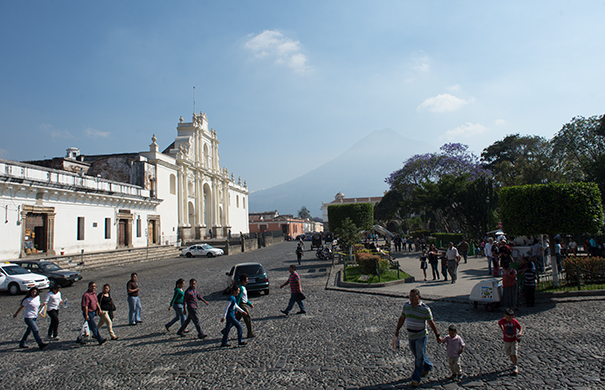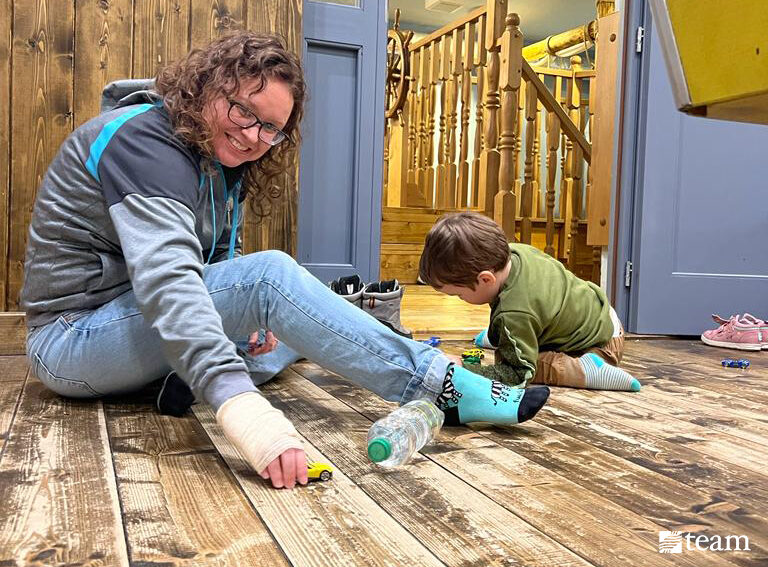
Missionary Life
Why the Church’s Future is Written in Spanish
March 8, 2018
by admin

If you want to know where the Church is growing, don’t look to your local seeker-friendly, hipster church. Don’t look for the closest liturgical service either. According to TEAM missionary and former missionary kid Justin Burkholder, the best place to look is in a Pentecostal service… in Latin America.
“We just sort of assume Latin America’s Catholic, … but a lot of Latin America is very evangelical, and mainly it’s highly neo-Pentecostal,” Justin says.
In 1970, evangelical Christians numbered only 12.8 million in Latin America. By 2020, they’re expected to reach 203 million, according to the Center for the Study of Global Christianity at Gordon-Conwell Theological Seminary.
That’s why Justin’s new church planting book, Sobre la Roca (On the Rock), isn’t written to North American missionaries. Now more than ever, Justin believes it’s vital to equip believers in what may soon be the global center of Christianity.
I talked with Justin about the challenges the Latin American church faces and how God is working through them. Our conversation has been edited for length and clarity.
You helped plant a Guatemalan church in 2015. What has that process shown you about the people of Guatemala?
We’re finding a lot of people that basically arrive at our church and this is the last chance that they’re giving church. They’ve been through the cycle of churches and a lot of people come hurt and wounded by different church leaders and some of the teaching that takes place. So we, in one sense, are a little bit of a healing ground for people, and in another sense, we really want to see ourselves as an embassy of God’s mission in that we want to send people. You know, we want to be senders out into Guatemala City. …
Guatemala is riddled with prosperity gospel. There are huge, huge contrasts in Guatemala in terms of — they say it’s 50 to 60 percent evangelical here, but Guatemala’s got one of the highest rates of violence in Latin America. There are close to 400,000 orphans that are here. So it’s just contrast. You see this huge dichotomy between what people say they believe and what actually ends up happening day-to-day in Guatemala.
What would surprise the average North American Christian if they saw the church planting situation in there?
Our churches per capita are way higher here than they are in a lot of cities in the United States. Guatemala’s one of the top 10 countries with the most megachurches in the world.
A lot of these neo-Pentecostal churches, they multiply … very quickly but don’t have a particularly healthy doctrine. And we’ve got churches that have a healthy doctrine but have absolutely no mission practice whatsoever. And so the idea is really to help both of these groups think healthy ways and biblically about the way they do church planting and the reasons they should do church planting.
Why is it that these churches with bad doctrine spread so quickly? And how do you try to combat that?
I think the main message here that spreads very quickly that we believe is unhealthy is the prosperity gospel. … So, one of the things that I try to talk about a lot in the book at the very beginning is what the church is. Because the church is God’s people who have been called out from darkness. But it’s ultimately a family who’s been sent on mission.
The idea is that the Gospel, the true, godly, biblical Gospel actually meets and satisfies all of my needs to the point that I can be commissioned and sent out to serve and care for others. And so I’m not actually coming to church necessarily for what I can get out of this. I now can live an others-focused life because I have Jesus. There’s nothing else that I could possibly need and there’s nothing this world could offer me that’s more valuable than that.
In your book, you talk about how to prepare a church planter and how they should prepare their teams. What are the key points you focus on?
There are four main elements I talk about: pray together, eat together, grow together and serve together.
“Pray together” is where we’re actually digging deep into each other’s lives and hearts and understanding what’s happening. Not just that, but praying together, ultimately, for God’s mission to be accomplished through us. …
Then “eat together” is just spending time together. And this is what we see the New Testament church doing all the time. In Acts 2, it talks about how after they would go to the Synagogue, they’re back in each other’s homes, breaking bread. … Even Jesus is praying in John 17 when He says that “they would be one, the way that We are one so that the world would know that You have sent Me.” So the world observing the way that the church loves each other and cares for each other affirms the message that the church says to believe.
“Grow together” is now getting into the nitty-gritty of like, alright, we’re going to confront each other and we’re going to exhort each other and we’re going to encourage one another.
And then “serving together” is being in the city and in the community where they’re going to church plant together and considering the needs of the city and listening to the city and asking questions of the city. Then discovering the ways that, with the assets that the city already has and that they already have, be able to care for and love their neighbor that lives there in the city together — hopefully with the opportunity to share the Good News of Jesus Christ.
Ready to keep reading? Purchase Justin’s book today!
What excites you about the future of the Church in Latin America?
That it is growing. … The future most definitely is in the Global South, and we will see Latin Americans be able to go into places that us North Americans will never be able to enter into just because there’s shared culture, there’s shared heritage, there’s shared history. There are all sorts of things and advantages that they have that we North Americans just don’t.
I think that as we plant churches, we will hopefully see a movement toward the nations. Which is ultimately, when we think about all the different unreached people groups, man, I just see our Latin American brothers and sisters way more on fire about some of this stuff. That’s what excites me.

